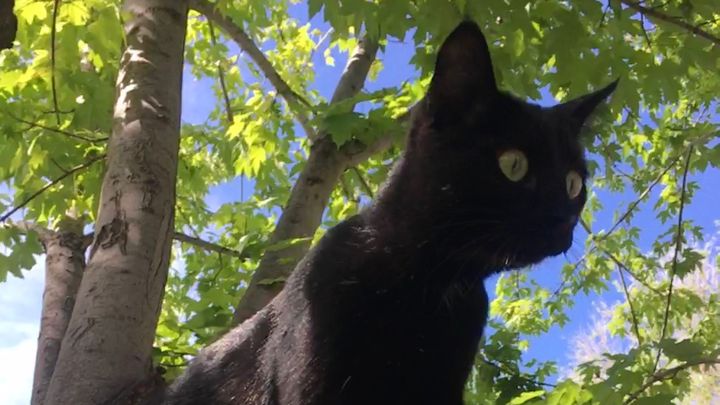
Help Cade Kitty Fight FIP!
Donation protected
I first met Cade as a hissing feral black kitten on the drilling rig Cade 24 in eastern Colorado in 2019. My old cat had died at 19 a few months prior. I had just lived through two hard years of a major surgery, a heartbreak, workplace harassment and a couple important jobs lost. I was on the road full time with no home base when I first saw her piercing green eyes under the trailers on the rig. I was in no place to take care of a kitten. I tried to catch her before the rig moved, but couldn’t. When I showed up at the new location 80 miles away my co-workers said “Your cat’s here.” She had been locked in a Conex box for 6 days. She ran up to me and ate out of my hand. Fuck it. I was going to figure out how to raise a kitten on the road. The cat distribution system had spoken.
I bought an 18’ camper and installed a cat door in it so I could keep her with me on different drilling locations. In the five years since then she has become a smart, sweet, spicy companion. She rides on my shoulder, loves walking on a leash and riding in the truck. She has grown into an elegant black cat with huge, expressive green eyes and a spicy, playful, half-wild but considerate temperament. She can survive outside in the city or National Forests of the Rocky Mountain west. She wakes me at dawn making biscuits on my chest and disappears into the tall grass of evening to hunt and eat her catch. My shiny black cat with her brilliant green eyes is my constant companion in a world that often misunderstands and excludes me.
I returned from a month long trip guiding Denali in early July to find her so skinny that I could see her spine. I took her to the vet, who suspected cancer. I fought hard for an appointment at the Colorado State University Veterinary Teaching Hospital closer than a month away. Once a fierce, athletic cat who leapt into trees, she lay panting on the cool earth under the trailer refusing to eat. CSU confirmed a diagnosis of Multiple Myeloma - terminal bone marrow cancer. I was devastated. I loaded up the trailer for one last seasonal migration to our summer camping spot in Idaho near my work in the Tetons. With its barns, tall grass and plum trees from the original homestead it is her favorite place. Even though she was only 5 1/2, I was going to give my baby girl the best days I could before I said goodbye.
As we drove the 9 hours from Colorado to Idaho I sang Brandi Carlile to her as she lay starving and exhausted on my lap, her safe place in the car. Singing to her was how I got her to trust me on the rig. She followed me around but wouldn’t let me touch her. She was so little and so quick and smart. I trapped her and kept her in the bathroom of my living quarters on the rig, singing Patsy Cline every day after my shift as she hid in a cardboard box. One night she came out and climbed into my lap and started to purr. So I sang to my dying friend as we drove because that was what I had done to comfort her since she was a baby.
I got a call in Idaho a few days later. The whole oncology team had been running tests on her blood, and determined she did not have cancer. It was a rare presentation of FIP - Feline Infectious Perotinitis - cat COVID. It used to be fatal, but on June first of this year the medication to treat it was approved for manufacture and sale by US pharmacies. I overnighted the medication and watched my best friend come back from the brink of death. One month into treatment she is running full-tilt across the field to throw her sleek little body against my legs when I come home from work. She has regained the lost weight and is her playful, fierce, feral self again.
Between diagnostic tests, many vet visits, and the miracle drug that is GS-441524, an antiviral developed to fight coronaviruses I am into this cure almost $6,000. FIP is curable, but the cure is expensive.
I’m so, so grateful for the team at the CSU Veterinary Teaching Hospital for persevering and diagnosing her correctly and so grateful that the drug to treat this just became available a month and a half before Cade needed it. She is back to her normal weight and is her spicy self again, playing fierce attack games with pieces of grass or my hand and hunting until dawn. In sharing Cade’s story I hope to spread the word that there is a very effective cure for FIP available. There isn’t a definitive test for FIP, but cats will drastically improve on GS-441524 within 2-5 days. I was about to start syringe feeding Cade the day she started the medication. All she would eat is chevre - goat cheese. Within 3 days she was eating wet food and starting to run around the yard again. If a cat improves on GS, it has FIP. I want to tell people who are unsure but suspect FIP not to wait.
Thank you for reading our story and for your help with this very worthwhile, very expensive new part of Cade’s and my journey together!
Organizer
Aili Farquhar
Organizer
Victor, ID